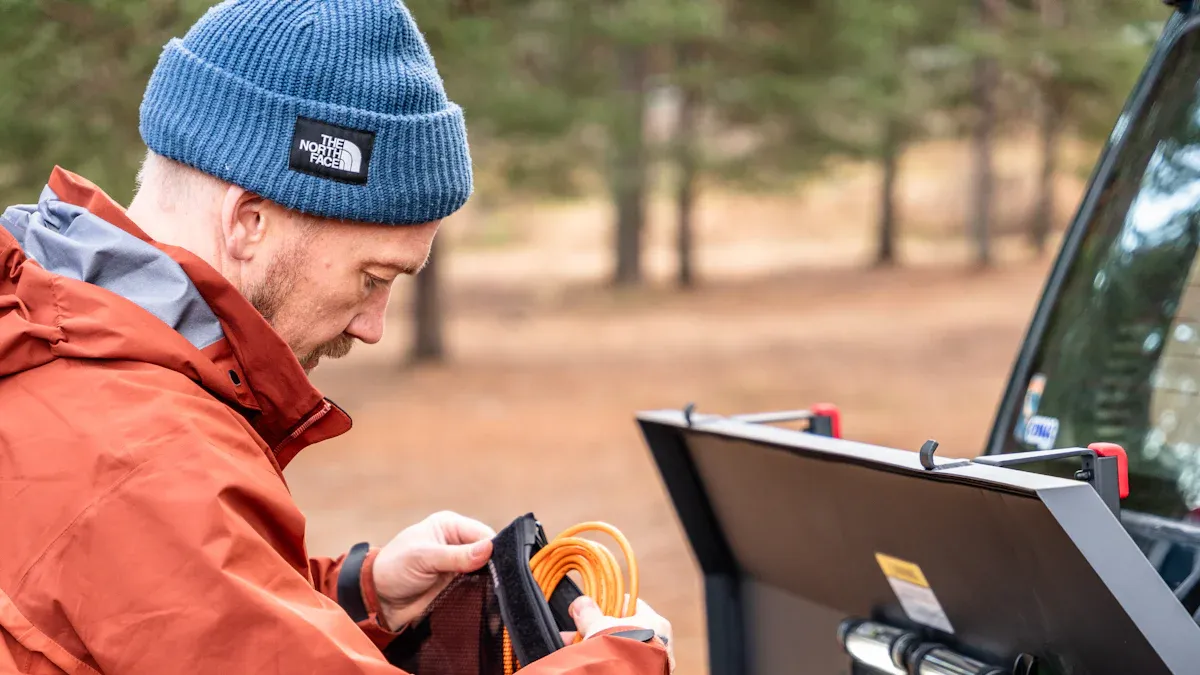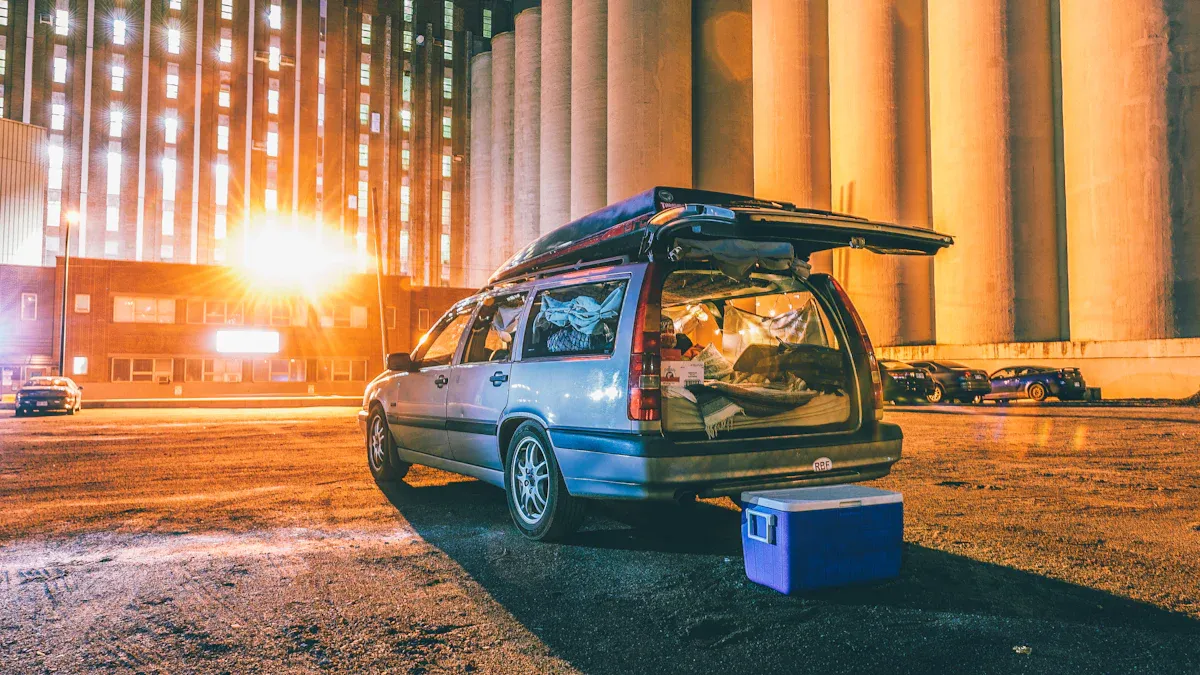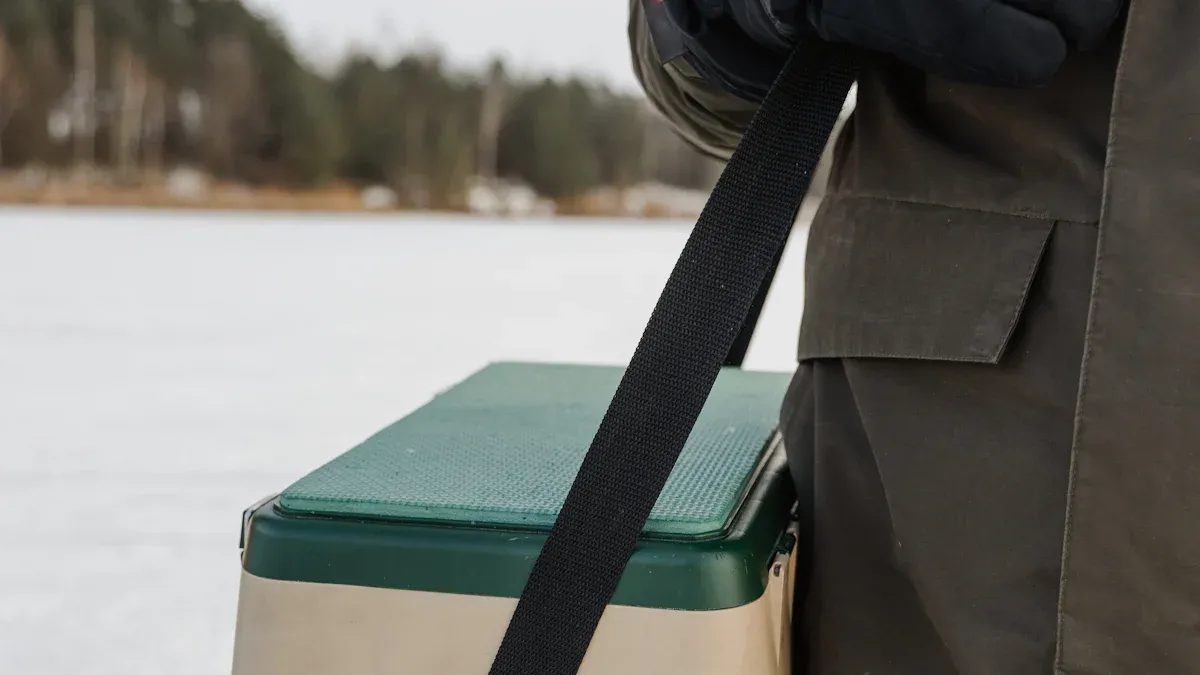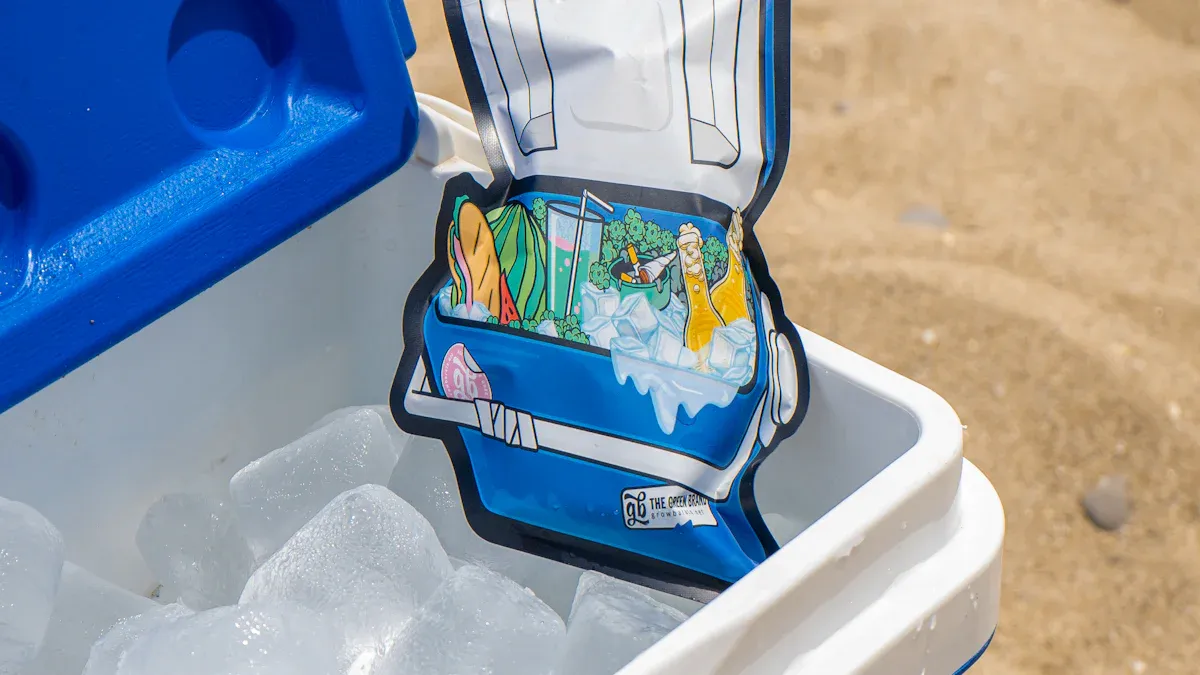

Picking the right ice cooler container can make your trip so much better. You want something that fits your plans and keeps things cold for as long as you need. People today look for coolers that are easy to carry, last a long time, and work well—especially for camping, picnics, or festivals. Many folks now also want eco-friendly choices and smart features. When you choose, think about what you need and avoid mistakes like packing warm items or leaving your cooler in the sun.
Key Takeaways
- Choose a cooler size that matches your trip length and group size to keep food and drinks cold without carrying extra weight.
- Pick hard-sided coolers for durability and long trips, and soft-sided coolers for light, short outings.
- Look for thick insulation and airtight seals to keep ice longer and maintain cold temperatures.
- Select coolers with sturdy handles, wheels, or backpack styles to make carrying easier on different terrains.
- Clean your cooler after each use and use good drainage to prevent odors and keep it lasting for many adventures.
Ice Cooler Container Size and Capacity
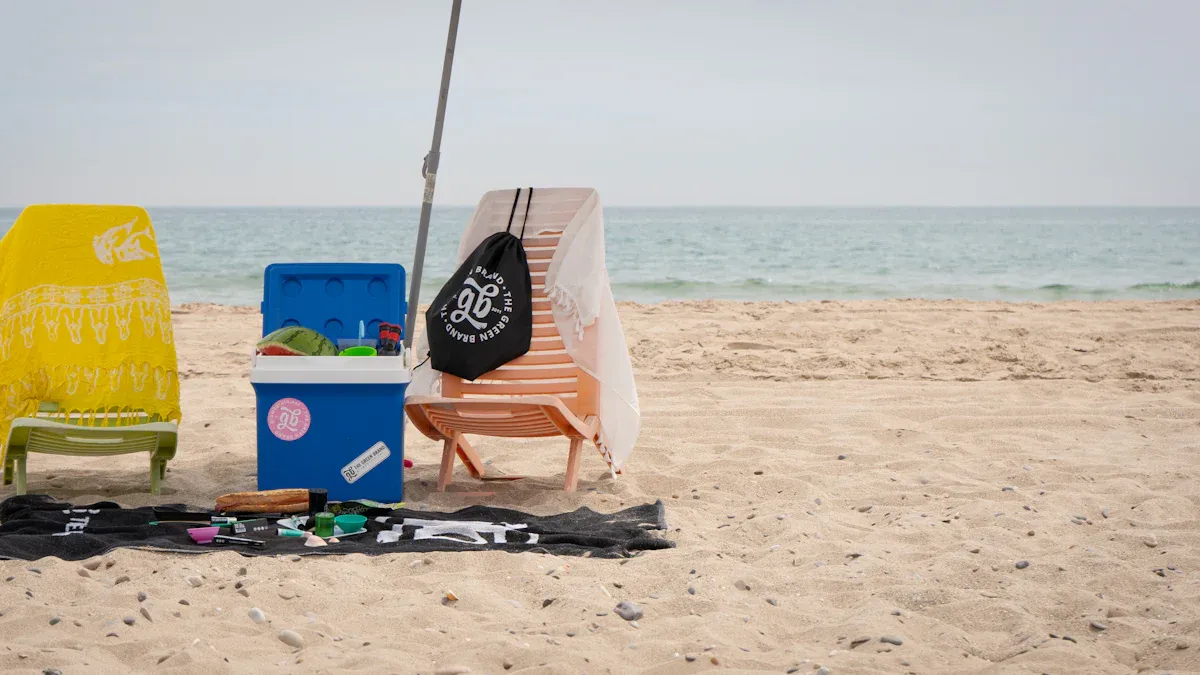
Matching Size to Trip Duration
Choosing the right size for your ice cooler container starts with thinking about how long you’ll be away. If you’re heading out for just a day, you don’t need a huge cooler. A small one, around 15 to 24 quarts, works great for solo trips or quick outings. For a weekend adventure with friends or family, you’ll want something bigger—think 45 to 65 quarts. Planning a week-long camping trip or a big group event? Go for a large cooler, maybe even 75 quarts or more.
Here’s a handy table to help you match your trip length and group size to the right cooler size:
| Trip Duration / Group Size | Recommended Cooler Size (Quarts) | Example Cooler Models |
|---|---|---|
| Day Trips (Solo) | Small (14-24L / 15-24 qt) | Roadie® 24, Daytrip® 14L Tote Bag, Hopper Flip® 12 Soft Cooler |
| Weekend Adventures (2-3 days, 2-4 people) | Medium (45-65 qt) | Tundra® 45, Hopper® M30 Soft Cooler, Hopper Flip® 18 Soft Cooler |
| Extended Journeys (1 week or more, 4-6+ people) | Large (75-250+ qt) | Tundra® 75, Tundra® 105, Tundra® 160, Tundra® 210, Tundra® 250 |
Tip: Always try to keep a 2:1 ratio of ice to food and drinks. This helps your cooler stay cold longer.
Group Size and Storage Needs
The number of people in your group makes a big difference when picking an ice cooler container. More people means you need more space for food, drinks, and ice. For a small group on a weekend trip, a 50-quart cooler usually does the trick. If you have a bigger group or plan to stay out longer, you might need two coolers—one for drinks and one for food. This setup helps keep things organized and makes it easier to find what you need.
- Cooler size goes up as your group gets bigger.
- A 50-quart cooler can hold about 50 cans plus ice, perfect for a small group.
- For longer trips or larger groups, use bigger coolers or bring more than one.
- Stick to a 2:1 ice-to-contents ratio for long trips, and a 1:1 ratio for short ones.
- Bigger coolers keep ice longer, which is great for multi-day adventures.
- Think about how you’ll carry your cooler. Larger ones can get heavy, so balance size with how easy it is to move.
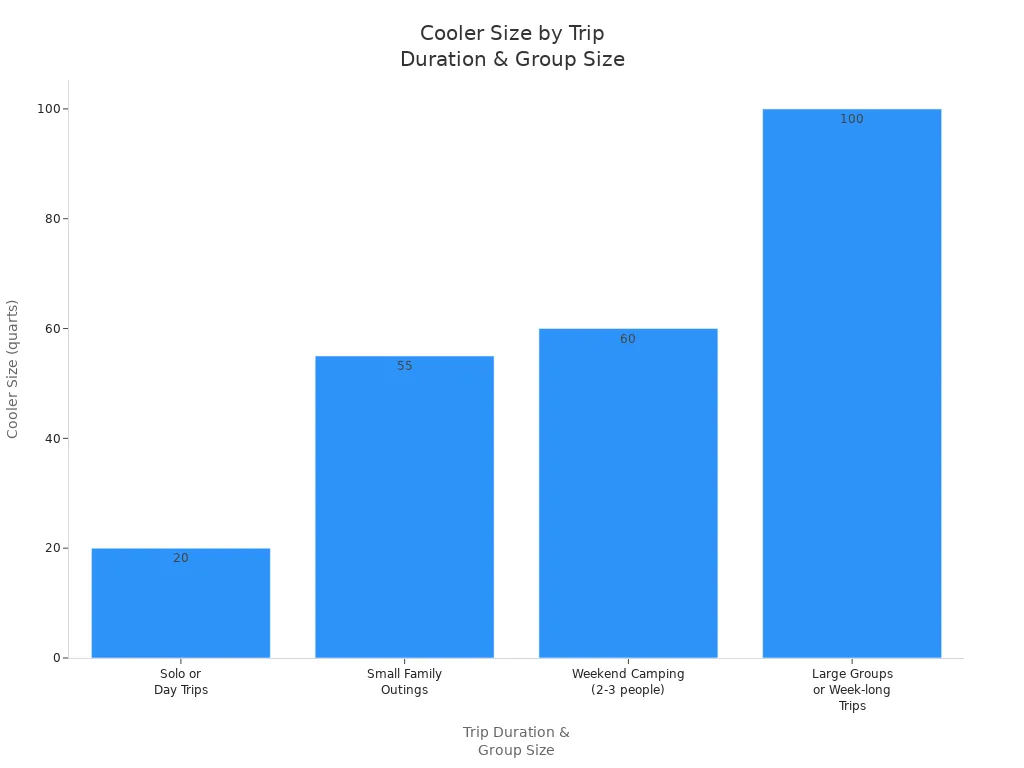
Size Recommendations by Activity
Your favorite outdoor activities also help decide which ice cooler container fits best. For a solo day trip, a cooler under 15 quarts is usually enough. If you’re camping overnight with a friend, try a 15-25 quart cooler. Small families or couples on multi-night trips do well with 25-45 quarts. If you’re planning to store a lot of meals or keep a day’s catch fresh, look for a 45-60 quart cooler. For long, off-grid camping trips, go for something over 60 quarts. Hard-sided coolers work best for longer trips because they keep ice frozen longer and stand up to rough use.
Here’s a quick guide for different activities:
- Weekend Getaway (Small Group): Pick a 35 or 55-quart cooler for short trips.
- Family Camping Trip (3-Day Weekend): A 65 or 75-quart cooler gives you plenty of space.
- Extended Expedition (Large Group): Choose a 100+ quart cooler for big groups and long trips.
- Day Trips & Picnics: Lightweight, 20 or 30-quart coolers are easy to carry and perfect for short outings.
- Active Overnight Trips (Small Group): Cooler backpacks around 30 quarts are great for fishing or hiking.
Note: If you want to keep things even colder, use two smaller coolers—one for drinks and one for food. This makes it easier to grab what you need without letting out too much cold air.
Ice Cooler Container Material and Durability
Hard-Sided vs. Soft-Sided Options
When you pick an ice cooler container, you face a big choice: hard-sided or soft-sided. Hard-sided coolers use tough materials like plastic, metal, or fiberglass. These coolers handle rough handling, drops, and bumps. You can take them on rocky trails or toss them in the back of your truck. They last a long time and keep your food safe. Soft-sided coolers feel lighter and easier to carry. They work well for short trips or picnics. However, they do not hold up as well in harsh conditions. Over time, you might see more wear and tear on a soft-sided cooler.
- Hard-sided coolers: rugged, impact-resistant, great for outdoor adventures.
- Soft-sided coolers: lightweight, easy to carry, best for quick outings.
Tip: If you want a cooler for camping or fishing, go with a hard-sided option for better durability.
Best Materials for Different Environments
Coolers come in many materials. Polyurethane foam stands out for its excellent insulation. It keeps things cold for a long time, even in hot weather. You might pay a bit more, but you get better performance. Expanded polystyrene (EPS) foam also insulates well, but it is not as strong and can harm the environment. Polyethylene-based coolers offer a good balance. They work well for most trips and cost less. Rotomolded plastic coolers combine thick insulation with strong walls. These coolers perform well in both hot and cold places. If you plan to use dry ice, look for containers with thick insulation and airtight seals.
Durability Tips for Outdoor Use
Outdoor adventures can be tough on your cooler. You want it to last. Here are some tips:
- Do not let dry ice touch the cooler walls directly.
- Loosen the drain plug if you use dry ice to avoid pressure buildup.
- Place dry ice on top of your food, not at the bottom.
- Avoid overloading your cooler to prevent damage.
If you follow these tips, your ice cooler container will stay in good shape for many trips.
Ice Cooler Container Insulation and Ice Retention
Comparing Insulation Performance
When you look at coolers, insulation makes a huge difference. The best ice cooler containers use thick, closed-cell foam—sometimes up to 4 inches thick. This type of foam traps air and keeps heat out. You get longer ice retention because the cold stays inside. Some coolers add reflective layers, like aluminum films, to bounce heat away. These layers can cut down radiant heat by up to 95%. Rotomolded designs and airtight gaskets also help. They stop warm air from sneaking in. Tests show that closed-cell foam with a foil layer can keep ice for about 8 hours longer than plain foam. Styrofoam coolers work because they have lots of trapped air, but they usually only keep ice for a day or two.
- Thick insulation (2–4 inches) means better ice retention.
- Closed-cell foam and reflective layers boost performance.
- Rotomolded and airtight designs keep cold air locked in.
Tip: If you want your food and drinks to stay cold for days, pick a cooler with thick, high-quality insulation.
Understanding Ice Retention Ratings
You might see coolers advertise how long they keep ice, but there is no official industry standard for these ratings. Brands test their coolers in different ways. Some use block ice, others use cubes or dry ice. The temperature outside, how often you open the lid, and even the type of ice all change the results. Because of this, ice retention numbers are just a guide. Your real results may vary. Always check how the company tested their cooler before you buy.
Top Models for Long-Lasting Cold (including KUER)
Some coolers stand out for keeping things cold the longest. Here are a few top picks:
- XSpec 60QT and Yeti Tundra 65: Both keep ice for about 9 days and stay below 40°F for 11 days.
- Yeti Roadie 48: Holds ice for 10 days, even though it is not rotomolded.
- Canyon Pro 45: Passes 5-day ice retention tests with ice still inside.
- Calcutta Renegade and Otterbox Venture: Both use advanced insulation and perform well in tests.
KUER coolers also use thick, high-quality insulation and rotomolded construction. This design helps them compete with other top brands for ice retention. You can count on a KUER ice cooler container to keep your food and drinks cold for your whole trip.
Ice Cooler Container Portability and Ease of Use
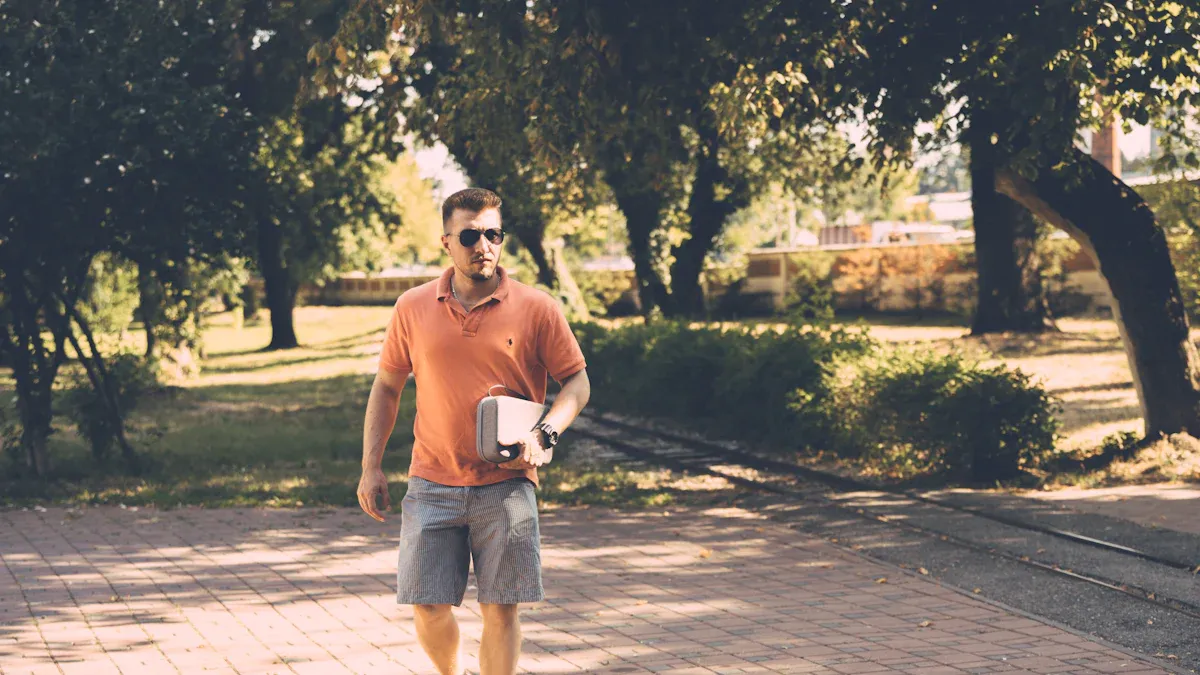
Handles, Wheels, and Carrying Features
When you pick an ice cooler container, you want it to be easy to move. Look for coolers with sturdy, ergonomic handles. These handles help you carry a full cooler without hurting your hands. Some coolers have wheels, which make a big difference when you need to roll your cooler across grass, sand, or pavement. If you plan to walk a lot, wheels can save your back and arms. Some coolers even come as backpacks, so you can carry them on your shoulders. This style works well for hiking or fishing trips. Other handy features include built-in drainage systems for quick cleaning and bottle openers for convenience.
- Lightweight construction makes carrying easier.
- Compact or collapsible designs save space in your car or tent.
- Extra features like USB charging ports or LED lights add convenience for outdoor use.
Tip: Choose a cooler with non-slip feet to keep it steady on uneven ground.
Weight and Travel Considerations
Weight matters a lot when you travel. A heavy cooler can slow you down, especially if you need to walk far. For backyard or car camping, a medium-size, lightweight cooler works best. If you go RV camping, you might want a bigger, more durable cooler with great insulation. Backpackers often pick soft-sided coolers because they are light and easy to pack. Large hard-sided coolers can weigh over 50 pounds when full, so they are not great for long hikes. Wheeled coolers help with heavy loads, but they work best on flat surfaces. New materials and smart designs now make coolers lighter without losing strength.
- Soft coolers weigh less and are easier to carry.
- Hard coolers offer better ice retention but are heavier.
- Think about your trip and pick a cooler that matches your needs.
User-Friendly Access and Design
You want your cooler to be easy to use, especially outdoors. Some coolers have special lids that stay open at different angles, so you can grab snacks without the lid slamming shut. Top-loader latches let you open the cooler even when it is packed in a tight spot, like a truck bed. Handles with a secure grip help you carry the cooler safely. Built-in bottle openers and quick-drain plugs make life easier at the campsite. Anti-slip feet keep your cooler steady, even on rocky or wet ground. Spill-resistant designs and tight lids keep out bugs and dirt, so your food stays safe.
Note: A good ice cooler container balances easy access, strong handles, and smart features for a better outdoor experience.
Ice Cooler Container Cleaning and Maintenance
Easy-to-Clean Surfaces
You want cleaning your ice cooler container to be quick and simple. Smooth wall construction helps a lot. Surfaces made from FDA/USDA-approved low-density polyethylene plastic resist stains and make wiping down the inside easy. Some coolers use special epoxy coatings that create a strong, smooth layer. These coatings help stop food and liquids from sticking. Take a look at this table to see what makes a surface easy to clean:
| Feature | Description |
|---|---|
| Material | FDA/USDA approved low density polyethylene plastic |
| Wall Construction | Smooth walls for easy cleaning |
| Cleaning | Surfaces resist stains and wipe clean fast |
| Additional Benefits | Durable, reusable, and user-friendly |
Tip: After each trip, wash your cooler with warm, soapy water and let it dry with the lid open.
Drainage and Odor Prevention
Nobody likes a smelly cooler. Standing water inside your ice cooler container can lead to mold and bad odors. Make sure your cooler has a good drainage system. Always check the drain plug and clear out any clogs. Here are some steps to keep things fresh:
- Empty melted ice and water after every use.
- Rinse the inside with a vinegar solution if you notice any mold.
- Dry the cooler completely by leaving the lid open in a well-ventilated spot.
- Fix leaks or faulty drains right away to stop moisture from building up.
Note: Regular cleaning and good airflow help prevent mold and keep your cooler smelling fresh.
Maintenance for Longevity
You want your cooler to last for years. A little care goes a long way. Set up a simple maintenance routine:
- Check door seals and hinges often to make sure they close tightly.
- Clean the drain lines every year to stop water from freezing or causing damage.
- Wipe down the inside and outside every month to remove dust and dirt.
- Handle the lid and doors gently to protect the seals.
- Use the right power supply if your cooler has electronic parts.
Keeping up with these steps helps your ice cooler container stay in top shape for every adventure.
Ice Cooler Container Price, Value, and Warranty
Comparing Price Points and Features
When you shop for an ice cooler container, you’ll notice prices can jump a lot. Size, material, and brand all play a big part. Smaller coolers or ice bricks made from food-grade HDPE cost less, but prices often depend on the seller. Stainless steel coolers usually cost more because they last longer and look sharp. Some brands add special features like removable lids, built-in trays, or extra insulation. These extras can raise the price, but they also make your cooler more useful.
Here’s a quick look at how prices and features compare:
| Brand | Size (inches) | Material | Price (USD) | Warranty | Features |
|---|---|---|---|---|---|
| Lynx | 19 x 18 x 14.6 | 304 Stainless Steel | $929.00 | 1 year | Removable lid |
| BBQGuys | 25.3 x 25.3 x 11.8 | 304 Stainless Steel | $1,019.99 | Lifetime | Welded corners, condiment holder |
| RCS | 24 x 18 x 15 | 304 SS lid/unknown | $569.00 | Lifetime | Strainer, plug, removable lid |
| Saber | 24 x 18.3 x 13 | 304 Stainless Steel | $649.00 | 5 years | Lift-up lid, drain plug |
| Hestan | 25.4 x 25.4 x 16 | 304 Stainless Steel | $1,249.00 | 1 year | 1-inch insulation, condiment trays |
| Coyote | 25.7 x 20 x 15 | 304 Stainless Steel | $699.00 | N/A | Hinged lid |
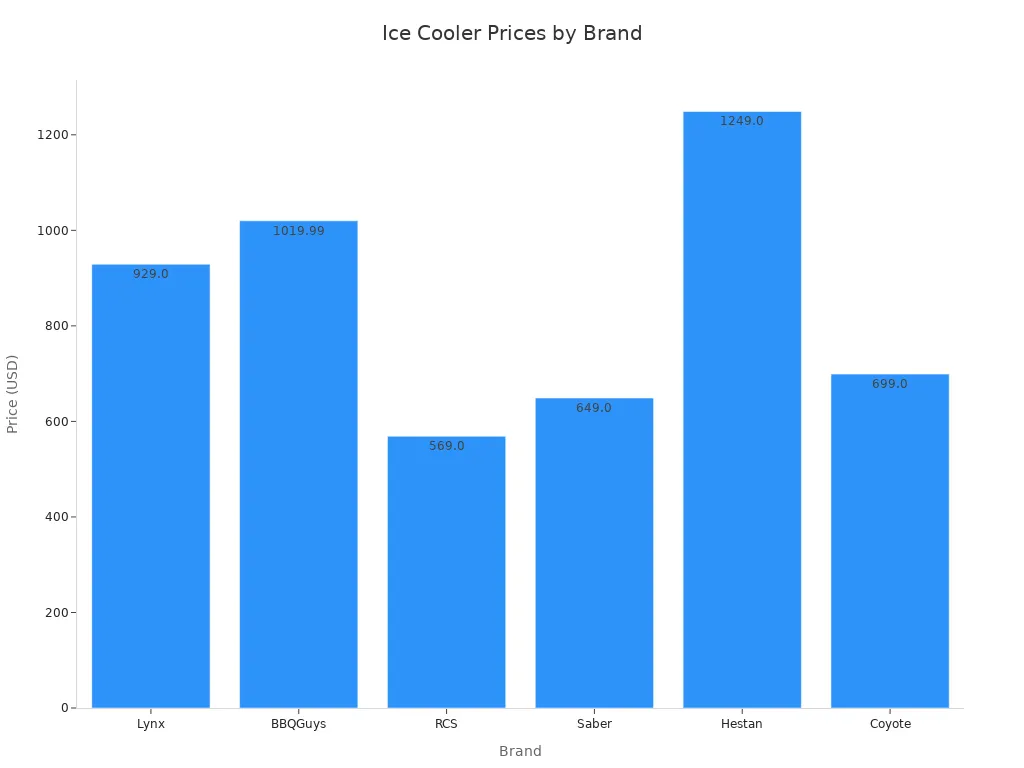
Tip: Think about what features matter most to you before you pay for extras.
What to Look for in a Warranty
A good warranty gives you peace of mind. You want to know your cooler will last. Here are some things to check:
- Warranty length: Some brands offer 5 years or even a lifetime for hard coolers.
- What’s covered: Look for coverage on defects in materials or how it’s made.
- What’s not covered: Most warranties don’t cover damage from accidents, misuse, or normal wear.
- Proof of purchase: You’ll need your receipt if you ever make a claim.
- Claim process: Some brands want you to contact customer service first or fill out a form.
- Parts: Good warranties may cover parts like drain plugs, latches, or handles.
- Shipping: You might have to pay for shipping if you send your cooler in for repair.
Note: Warranties usually only help the first owner, so keep your receipt safe.
Best Value Picks (including KUER)
You want the best bang for your buck. Some brands stand out for value, balancing price and performance. The Igloo Trailmate 50 often gets called the best value for money. RTIC coolers cost less than Yeti but still work well. Yeti coolers offer top ice retention and comfort, but you pay more. Pelican coolers shine with their strong warranty.
KUER coolers also give you great value. They use quality materials and smart designs. You get reliable ice retention and sturdy construction without breaking the bank. KUER’s focus on research and development means you get a cooler that lasts, making it a smart pick for your next adventure.
Choosing the right ice cooler container makes every trip smoother and more fun. Here’s a quick look at what experts suggest:
| Key Factor | Expert Tip |
|---|---|
| Size and Capacity | Pick a cooler that fits your group and trip length. |
| Cleaning | Go for easy-to-clean surfaces and drain plugs. |
| Price and Warranty | Balance cost with a good warranty for peace of mind. |
| Material/Insulation | Durable plastic and thick insulation keep things cold longer. |
You get more out of your adventures when you match your cooler to your plans. A high-quality cooler keeps food fresh, doubles as a seat, and stands up to tough outdoor use. You’ll enjoy every meal and moment even more!
FAQ
How do I choose the right size ice cooler container?
Think about your trip length and group size. For a solo day trip, pick a small cooler. For family camping, go bigger. Always leave space for ice. If you’re unsure, bigger is usually better.
What’s the best way to keep my cooler cold longer?
Pre-chill your cooler before packing. Use plenty of ice or ice packs. Keep the lid closed as much as possible. Store your cooler in the shade. Cold air stays in, and your food stays fresh.
Can I use dry ice in my cooler?
Yes, you can use dry ice in many hard-sided coolers. Always check the manufacturer’s instructions first. Handle dry ice with gloves. Never let it touch the cooler walls directly.
How do I clean my ice cooler container?
Wash your cooler with warm, soapy water after each use. Rinse well and let it dry with the lid open. For tough smells, use a mix of water and vinegar. Regular cleaning keeps your cooler fresh.
What features should I look for in a cooler for outdoor trips?
Look for sturdy handles, strong insulation, and easy-to-clean surfaces. Wheels help with heavy loads. Drain plugs make cleaning simple. Some coolers even have bottle openers or cup holders for extra convenience.

